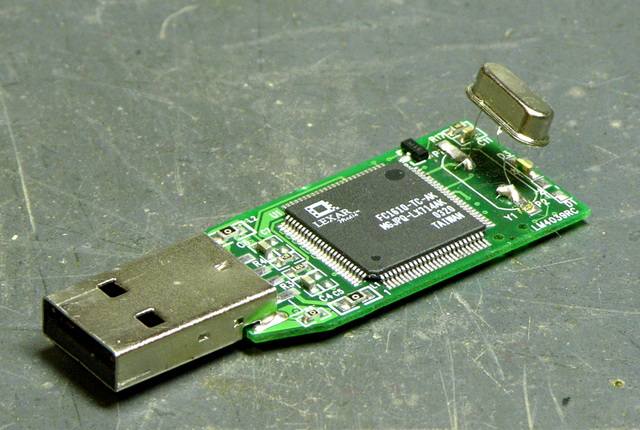A couple of weeks ago, Matt from the desktop support group at work asked me for soldering advice / demonstration. Someone he supports kept all her data on a USB thumb drive with no backup, and it stopped working. When he opened it, he found the crystal had come off the board, and he wondered whether I could solder wires to it well enough to get the drive working and retrieve the data before discarding the drive.
It turns out the crystal was a through-hole design that had had its legs crimped into flat strips, then bent out sideways to surface-mount. (You can see the pads where it was originally mounted.) But that created stress points at the end of the crimped area where the leads were bent, and the owner treated the drive roughly enough (I think attached to her keychain that she dropped onto the counter every night) that both legs sheared clear off.
Didn’t leave me much to solder to, either, but I got it done. Matt’s too young to know wire wrap and didn’t have any on hand, but I found some stranded wire and used a single strand. It wasn’t an elegant job, but it was sturdy enough to survive some handling, and it actually worked. In spite of his professed faith in my abilities, Matt was amazed and delighted when he plugged in the drive and the contents popped right up on his computer.
And I get to keep the repaired drive as my reward. Which naturally means that I’ve already broken one of the wires. ![]()

Hum, really funny this broken USB drive
Check http://www.larsen-b.com/Article/288.html, for my experience with the same kind of issue
Interesting. I happen to have a broken USB drive (although it doesn’t contain any critical data). I’m guessing that mine is broken due to a fractured crystal, which most likely happened when I dropped it. I have on my list of things to do to try replacing the crystal. So, this has been very informative.
Dave
Dave, when I did it, I wondered whether the wiring job would mess with the timing of the crystal or permit too much interference in its signal, but it sure seems to work okay.
You’re afraid the damage may be internal to your crystal? I guess that makes sense; or it could simply have popped one of the leads loose from the solder pad.
Definitely seems to be worth a try replacing it!
No, I’m pretty sure that just about any wiring job you could reasonably do in the limited space available wouldn’t affect the crystal’s timing. There are several ways that a crystal’s timing can be affected. These are usually capacitive (or inductive) electrical loading, or mechanical loading on the crystal’s face. Having worked with some crystals, I’m somewhat familiar with the behaviour of Quartz crystals, and know that it takes quite a bit of electrical loading to pull the frequency very far. And, with the timing tolerances of the USB bus, even a few hundred Hz shouldn’t matter.
http://pw1.netcom.com/~wa4qal/crystal.htm
As for interference, there are a couple of kinds that cause problems with Quartz crystals, but most of these are pretty minimal effects. One problem is with jitter, but this usually only affects the phase of the signal, and tends to average out over time (It can cause grief if you’re using the crystal for a very precise local oscillator in a receiver, but the effect is usually better than for just about any other kind of local oscillator, unless the feedback amplifier is particularly noisy.). Some crystals can do what is called mode or frequency jumping, where the frequency of oscillation suddenly shifts, sometimes in relationship to electrical circuit parameters shifting (perhaps due to mechanical changes, or even thermally induced changes). However, this is usually related to the geometry of a particular crystal, and one would hope that a commercially produced crystal is void of these issues. There is also the issue of overtone operation, but one would hope that for the relative low frequencies used for USB drives, the crystal is a fundamental mode crystal.
The largest concern may be radiated electrical noise, but these crystals usually operate in the mW, if not uW range, so there is not much energy to be radiated.
Most of the packaged crystals used now are made by cutting a Quartz slab (and, note that the orientation of the cut with respect to the crystallographic axes is important, since this affects thickness versus frequency, temperature coefficient, vibrational mode, etc.), grinding/polishing/etching it to the desired frequency, and then Silver plating electrodes on it, which are then attached to wire leads. I’m thinking that, for the USB drive I have, that either the Quartz slab fractured (which is possible, since Quartz is quite brittle), or that one of the wire leads broke, probably where it connects to the Silver plating, inside of the crystal package.
My first thought would be to remove the crystal (which, if memory serves, is a 12.0 MHz crystal), and replace it with another one I have in stock (which, unfortunately, has a slightly different geometry, which means that I probably won’t be able to reassemble the drive into the original case, but it will allow/motivate me to create a custom case for it). Following that, I may perform a failure analysis of the perhaps broken crystal (e.g., Cut it open, using a Dremel tool with a cutoff wheel to expose the internal workings.). Now all I need is the time to actually do this.
Dave
I bent the USB off of a flash drive just now…
I really need the files off of it. Does anyone know where I can get help with that?
Marie, how exactly is it broken? The USB plug is bent off of it? Do you have a digital camera that you could post or email a pic of the damage?